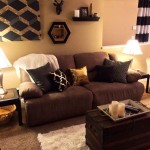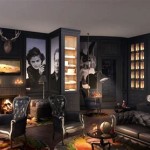Fairy Lights Wall Decor Ideas For Living Room
Fairy lights, also known as string lights or twinkle lights, have emerged as a versatile and popular element in interior design, especially in living rooms. Their delicate glow and adaptability allow them to be incorporated into various decorating schemes, adding a touch of warmth, whimsy, and personality. While traditionally associated with festive occasions, fairy lights can now enhance the ambiance of a living room year-round. Effective use of fairy lights involves careful consideration of placement, style, and the overall aesthetic of the room.
Choosing the right type of fairy lights is crucial for achieving the desired effect. LED fairy lights are generally preferred due to their energy efficiency, longer lifespan, and cooler operating temperature compared to traditional incandescent bulbs. The color temperature of the light is also important. Warm white or soft white lights create a cozy and inviting atmosphere, while cool white or colored lights can lend a more modern or playful feel. The length of the string should be appropriate for the intended area of coverage, and the power source, whether battery-operated, plug-in, or USB-powered, should be considered based on accessibility and convenience.
The following sections explore various ideas for incorporating fairy lights into living room wall decor, offering practical tips and considerations for each approach. These ideas cover a range of styles and techniques, catering to different preferences and design goals.
Creating a Fairy Light Curtain
A fairy light curtain is a visually striking and relatively simple way to transform a wall. This involves draping multiple strands of fairy lights vertically from a horizontal support, creating a shimmering backdrop. The support can be a curtain rod, a length of wooden dowel, or even a sturdy piece of string secured to the wall with hooks. The spacing between the strands can be adjusted to control the density of the light and the overall appearance.
To create a fairy light curtain, begin by measuring the width and height of the wall area you intend to cover. This will determine the length of the horizontal support and the required length of the fairy light strands. Purchase fairy lights with a sufficient length to reach from the support to the floor or to the desired endpoint. LED lights are recommended for this application due to their low heat output, especially if the curtain will be near fabric or other potentially flammable materials.
Next, attach the horizontal support to the wall. Consider the weight of the fairy lights when selecting mounting hardware. For heavier strands, use sturdy hooks or brackets. Ensure the support is level and securely fastened. Once the support is in place, begin draping the fairy lights over it. Space the strands evenly apart, creating a uniform curtain effect. Secure the lights to the support with small clips, zip ties, or tape. If desired, the bottom of the strands can be weighted down with small objects to keep them hanging straight.
Variations of the fairy light curtain include adding sheer curtains or fabric panels behind the lights to diffuse the glow and create a softer effect. Alternatively, decorative elements such as artificial flowers, leaves, or beads can be interwoven with the lights for added texture and visual interest. The color of the lights can also be varied to match the room's color scheme or to create a specific mood. For example, blue or green lights can create a cool and calming atmosphere, while warm white or amber lights can evoke a sense of warmth and intimacy.
Framing Art and Mirrors with Fairy Lights
Fairy lights can be used to highlight existing artwork or mirrors, adding a subtle and sophisticated touch. This approach involves carefully wrapping or outlining the frame with fairy lights, drawing attention to the piece and enhancing its visual impact. The choice of light color and arrangement can be tailored to complement the artwork or mirror's style and color palette.
When framing art with fairy lights, select lights that are proportionate to the size of the artwork. Smaller, delicate lights are generally preferred for smaller pieces, while larger lights may be appropriate for larger artworks. Consider the style of the artwork when choosing the light color. Warm white lights can enhance the warmth of traditional paintings, while cool white lights can complement the contemporary aesthetic of abstract art. Avoid using lights that are too bright, as they can overpower the artwork and detract from its details.
Secure the fairy lights to the back of the frame using tape, small clips, or adhesive putty. Ensure the lights are evenly spaced and that the wiring is concealed as much as possible. For a more subtle effect, tuck the lights behind the frame, allowing the glow to emanate from the edges. Alternatively, the lights can be wrapped around the frame, creating a more prominent and decorative border.
Mirrors can also be effectively framed with fairy lights. The lights will reflect in the mirror, creating a sense of depth and adding to the overall illumination of the room. Similar principles apply when framing mirrors as with artwork. Choose lights that are proportionate to the size of the mirror and that complement its style. Consider using a dimmer switch to control the brightness of the lights, allowing you to adjust the ambiance of the room as needed.
Creating Shapes and Patterns on the Wall
Fairy lights can be arranged on the wall to create various shapes and patterns, transforming a blank space into a personalized and eye-catching feature. This technique offers a high degree of creative freedom, allowing you to design custom wall art that reflects your individual style and preferences. Hearts, stars, geometric shapes, and even words or phrases can be formed using fairy lights.
Before attaching the lights to the wall, plan the design on paper or using a digital tool. This will help you visualize the final result and determine the required length of fairy lights. Consider the scale of the design relative to the size of the wall and the overall proportions of the room. Simple shapes, such as stars or hearts, are easier to create, while more complex designs may require more time and effort.
Use a pencil to lightly sketch the design on the wall as a guide. Then, begin attaching the fairy lights to the wall, following the sketched outline. Use small adhesive hooks, clips, or tape to secure the lights in place. Ensure the lights are evenly spaced and that the wiring is concealed as much as possible. For larger designs, it may be helpful to work in sections, completing one section before moving on to the next.
Variations of this technique include using different colored lights to create specific patterns or effects. For example, using multiple strands of different colored lights can create a rainbow effect or a gradient of color. Alternatively, using blinking or fading lights can add a dynamic element to the design. Consider adding other decorative elements, such as photos, artwork, or wall decals, to further enhance the design and personalize the space.
Incorporating Fairy Lights with Existing Wall Decor
Fairy lights can be seamlessly integrated with existing wall decor, such as shelves, tapestries, or plants, to enhance their visual appeal and create a more cohesive and layered look. This approach involves carefully weaving or draping the lights around the existing decor, adding a subtle glow and highlighting its features.
When incorporating fairy lights with shelves, consider wrapping the lights around the shelves themselves or draping them over the items displayed on the shelves. This can create a warm and inviting glow around books, plants, or other decorative objects. Ensure the lights are securely attached to the shelves and that the wiring is concealed as much as possible. Avoid overloading the shelves with too many lights, as this can create a cluttered and overwhelming look.
Tapestries can also be effectively enhanced with fairy lights. Draping the lights around the edges of the tapestry can highlight its intricate details and create a more dramatic effect. Alternatively, the lights can be woven through the tapestry, creating a subtle and shimmering texture. Choose lights that complement the colors and patterns of the tapestry. For example, warm white lights can enhance the warmth of a tapestry with earth tones, while cool white lights can complement the cool tones of a tapestry with blue or green hues.
Plants can also be incorporated with fairy lights to create a whimsical and enchanting display. Winding the lights around the branches or leaves of a plant can add a touch of magic and create a focal point in the room. Consider using battery-operated lights to avoid the need for nearby outlets. Ensure the lights are not too hot, as this can damage the plant. LED lights are generally preferred for this application due to their low heat output.
Using Fairy Lights with Photo Displays
Combining fairy lights with photo displays is a popular way to create a personalized and sentimental wall decor arrangement. This involves hanging photos from the fairy lights using clothespins or clips, creating a visually appealing and emotionally resonant display. This technique is particularly effective for showcasing cherished memories and adding a personal touch to the living room.
Start by stringing the fairy lights across the wall in a desired pattern. This can be a straight line, a zig-zag pattern, or a more organic and free-flowing arrangement. Use small adhesive hooks or clips to secure the lights to the wall. Ensure the lights are evenly spaced and that the wiring is concealed as much as possible. Choose lights that are proportionate to the size of the photos. Smaller, delicate lights are generally preferred for smaller photos, while larger lights may be appropriate for larger photos.
Once the lights are strung up, begin attaching the photos to the lights using clothespins or clips. Arrange the photos in a way that is visually appealing and tells a story. Consider alternating between horizontal and vertical photos to create a more dynamic display. Leave some space between the photos to allow the fairy lights to shine through. You can also add other decorative elements, such as postcards, ticket stubs, or small mementos, to the display to further personalize it.
Variations of this technique include using different types of clips, such as wooden clothespins, metal clips, or decorative clips. You can also paint or decorate the clothespins to match the room's color scheme. Consider using black and white photos for a more classic and sophisticated look, or use colored photos for a more vibrant and playful display. The addition of Polaroid-style photos can give a retro feel to the display.

12 Fairy Light Decor Ideas For Your Dorm That You Need To Try Now Society19 Wall String Lights Living Room In The Bedroom

Creashine String Lights Living Room Bedroom Decor

26 Gorgeous Ways To Decorate Your Home With String Lights

How To Decorate Your Apartment With String Lights Inspired By Anna

30 Romantic String Light Ideas For The Bedroom

These Fairy Light Ideas Will Be Great In Any Room 21oak

66 Inspiring Ideas For Lights In The Bedroom Diy

10 Ways To Use Fairy Lights Around Your Home And Where Buy Them

Fairy Light Ideas 30 Amazing Ways To Use String Lights At Home

How To Hang Fairy Lights String Indoors Pottery Barn Teen
Related Posts







